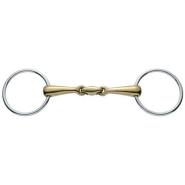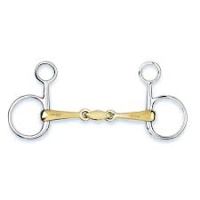Ever wonder what the purpose of a noseband is? Or a bit?

The overall goal of any bridle is to help the rider communicate with his horse, whether flatting or jumping. A simple bridle consists of two cheek pieces, a crownpiece, a throatlatch, a browband, a bit, and a noseband.
The noseband is an interesting piece. Many argue that the noseband is not needed at all, and that it is a harsh piece of equipment meant to hold the mouth closed. Originally the noseband was used during times of war to aid in keeping a horse’s mouth closed to prevent the noise made by him chomping on the bit. The noseband also helped the soldiers to control their horses; the tighter the band, the more control a soldier had.
Theoretically, a noseband should not be necessary for a correctly ridden horse. It can be very helpful with a young horse, who will open the mouth and resist contact, putting his tongue over the bit, trying to evade bar and tongue pressure. In this case, a noseband will encourage the mouth to close, although riders must be careful not to tighten the band too much. A rider should be able to fit two fingers between the noseband and the horse’s jaw, as well as between the band and the nasal bones. The noseband should sit approximately two fingers below the cheekbones, although this can vary slightly depending on the size, breed, and confirmation of the horse. They should be able to open their mouth enough to eat a treat with the bridle on.

To have contact, the mouth has to be closed, or various jaw muscles cannot relax. If a rider feels a noseband is not doing the job, he can add a flash to the bridle instead of overtightening the noseband. The flash will help keep the bit still and straight in the horse’s mouth, which can be especially helpful with the young horses. As with the noseband, a rider must be careful not to tighten the flash too much, and the horse should still be able to eat a treat with it on. The hope is that once the young horse learns proper contact, there will be no need to continue using a flash. Theoretically the horse should be able to be ridden without a noseband as well, however this piece is required in many disciplines.
The bit is a very important tool, if used correctly. There are many different types of bits, and in this article, there will be two categories discussed: soft bits and hard bits.
Soft bits (partial list):
- Loose Ring snaffle
- Eggbut snaffle
- Full Cheek snaffle
- Baucher
Hard bits (partial list):
- Dutch Gag
- Kimberwicke
- Pelham
- Gag


Each of these bits can have a different mouthpiece, the most common being a single or double joint (due to the complexity of the many different mouthpieces, only the basics will be discussed). A single joint puts pressure on the bars and the roof of the mouth as well as pinching the tongue (called the nutcracker effect) and can help to raise the head. A double joint puts pressure on the bars and the tongue and encourages the horse to bring the head down. With a basic snaffle bit, the amount of pressure put on the reins equals the amount of pressure felt by the horse’s mouth.

As you “bit up”, the pressure on the mouth increases. A Loose Ring is one of the gentlest bits because the ring can twist through the mouthpiece as pressure is applied to the reins and therefore alleviate most of the pressure from the rider’s hands. The Eggbutt is slightly harsher than the Loose Ring because it does not twist to alleviate pressure. The Full Cheek adds more pressure to the cheeks of a horse (as a rider adds pressure to one rein, the other side of the bit presses into the horse’s cheek), and if the cheeks are fixed with bit keepers, it can add some poll pressure as well. The last of the soft bits (although some believe it should be in the “hard” category), the Baucher, has a fixed ring for the cheekpieces to attach to, and as the rider puts pressure on the reins, the fixed ring is pulled toward the horse’s mouth, and adds a slight amount of poll pressure. Many riders use a Baucher to encourage the head to drop down, instead of creating a true bend in the body, although when used correctly, this bit can be a helpful tool to keep the horse from dragging down on the rider’s hands.
There are certainly specific instances when a rider should use a harsher bit, such as the ones listed above, however many use them to compensate for a lack of correct training. With proper training, the goal for any rider should be to ride in a loose ring, or at least a soft bit at home, whether flatting or jumping.
The ultimate goal is always to “bit down”, but if a rider needs to “bit up”, it must be done with careful training and soft hands. Remember, the horse’s comfort must come first, and only then can good quality training proceed.